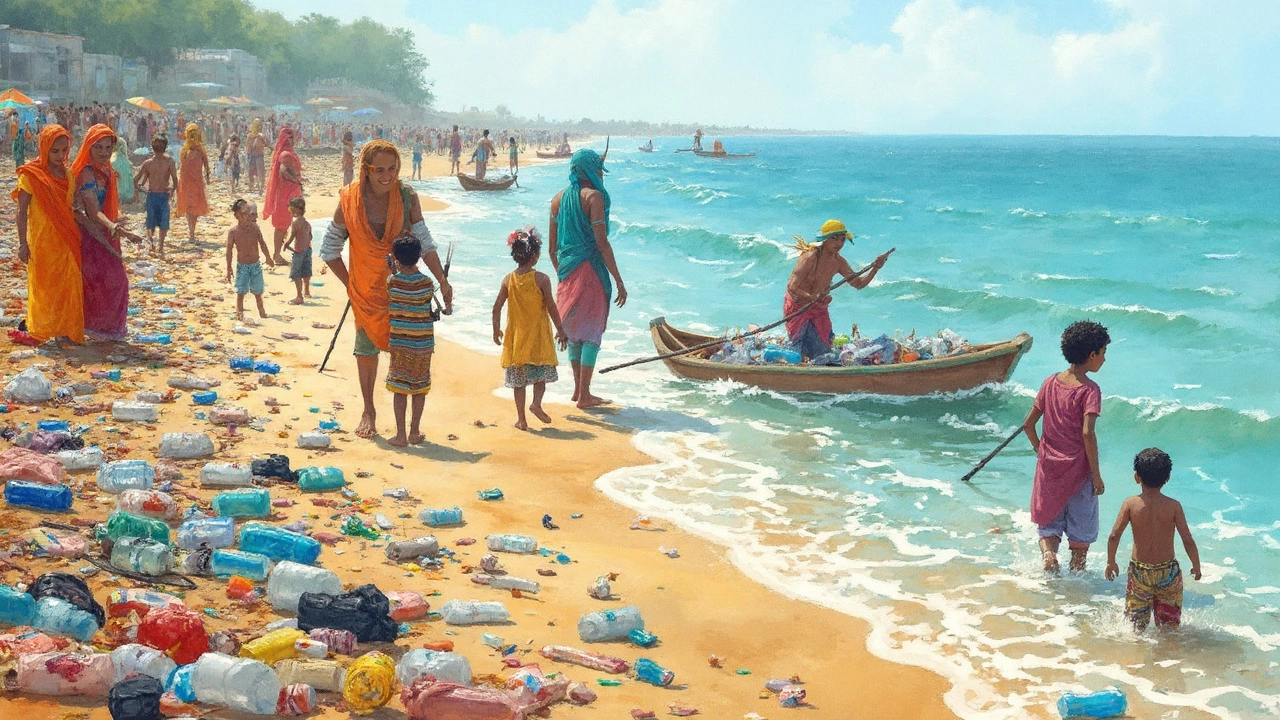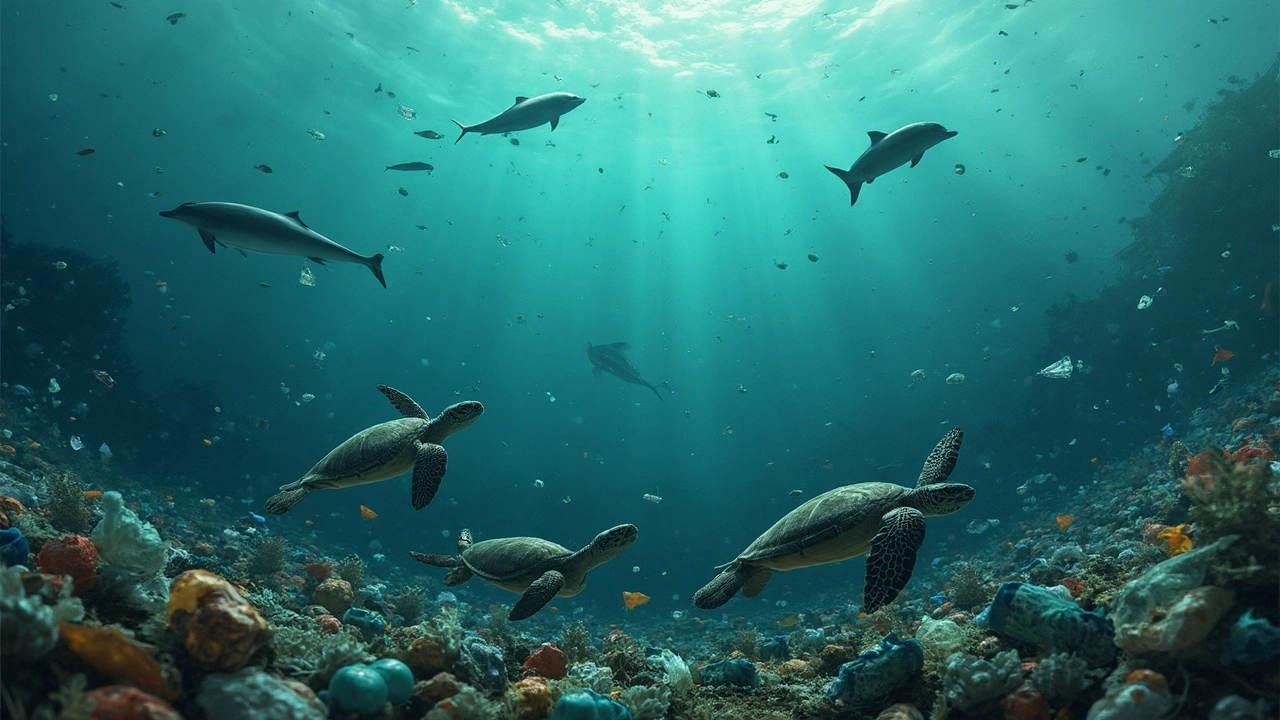 Jun, 13 2025
Jun, 13 2025
If you walked down a beach after a storm, you'd spot a mess of plastic: bottles, food wrappers, broken bits of packaging—it's not even subtle. Everywhere you look, it's basically a plastic graveyard. But if you had to bet on what you’re seeing the most, your money should be on single-use plastics. These are the everyday throwaways like water bottles, snack wrappers, grocery bags, and straws. They make up most of the plastic trash that ends up floating around our oceans. Why? They're everywhere, we use them for minutes, and then they stick around for hundreds of years.
Here's something wild: a 2024 study from the University of Georgia found that over 50% of beach plastic came from packaging—think candy wrappers, chip bags, instant noodle packets. Even plastic manufacturing companies admit that these items are just the tip of the iceberg. Labels from big brands are often found stuck to these bits, making it easy to trace the mess back to where it started.
- The Usual Suspects: Most Common Ocean Plastics
- From Factory Floor to Ocean Shore
- Why Microplastics Are a Big Deal
- What Can Plastic Companies and You Do?
The Usual Suspects: Most Common Ocean Plastics
Everyone talks about ocean plastic, but which types actually cause the most mess? If you sifted through ocean trash, it’d be clear: single-use stuff dominates. More than 80% of the plastic pollution you spot out there is from disposable packaging and short-lived products.
Check out the main offenders that show up the most, according to a 2023 Ocean Conservancy cleanup report:
- Plastic bags and food wrappers
- Beverage bottles (water, soda, juice)
- Caps and lids
- Straws and stirrers
- Takeout containers
Bottles and food packaging top the list. In fact, the Ocean Conservancy data shows that food wrappers now outnumber beverage bottles at beach cleanups worldwide.
| Item | Percent of Total Ocean Plastics (2023) |
|---|---|
| Food Wrappers | 31% |
| Beverage Bottles | 19% |
| Plastic Bags | 15% |
| Caps & Lids | 8% |
| Straws & Stirrers | 5% |
It’s not just brand labels you can spot—some studies tracked which types of plastic resin are most likely to pollute the ocean. Polyethylene and polypropylene (used in bags, bottles, and wrappers) make up most of the mess because they’re cheap, light, and everywhere.
Here’s an easy way to spot a problem product: If it’s something you use once and toss, like a shopping bag or a candy wrapper, it probably falls into the top polluter category for plastic pollution in the ocean.
From Factory Floor to Ocean Shore
Most of the plastic that washes up on our beaches started out in a factory, usually far from the sea. Plastic manufacturing companies churn out billions of tons each year, especially for single-use stuff. According to PlasticsEurope, a legit industry group, global plastic production hit 400 million tons in 2023. The problem? About 40% of that is tossed after just one use—so it’s not hard to guess where a chunk of it ends up.
Here's how the journey goes: big companies make plastic pellets (called nurdles), which are shipped all over the world to be melted into products. Sometimes, these tiny beads spill into rivers and ports even before anything’s made from them. Next, factories shape them into packaging, bottles, or wrappers, which are distributed everywhere—supermarkets, gas stations, vending machines. Once bought, people often dump them without a second thought. Depending on local waste systems, a lot of it ends up in dumps that leak, or the wind and rain carry items straight to waterways.
Take a look at some eye-opening numbers about where common trash items come from:
| Item Type | Main Source | Estimated % in Ocean Litter (by count, 2024) |
|---|---|---|
| Beverage Bottles | Bottling companies, retailers | 14% |
| Food Wrappers | Snack companies, packaging plants | 17% |
| Plastic Bags | Retailers, grocery manufacturers | 8% |
| Plastic Lids/Caps | Beverage manufacturing | 6% |
| Industrial Pellets (Nurdles) | Plastic manufacturers | 1-5% (high impact) |
Some of the worst leaks happen during transport. In 2021, a ship near Sri Lanka spilled over 80 metric tons of nurdles, causing a massive environmental headache for months. But it’s not always giant disasters—day-to-day operations at ports and factories regularly lose tiny bits of plastic that slowly add up.
If you ever wondered how your chip bag finds its way to the open sea, here’s the most common pathway:
- Made in a factory
- Sold in a shop
- Thrown away (often not recycled)
- Ends up in a landfill or tossed outside
- Rain and wind carry it to a river
- River carries it to the ocean
The road from plastic pollution to the ocean is mostly about what we make, how we package, and the waste systems we set up—or don’t. If plastic companies invest in better production controls and stricter shipping practices, this whole chain gets a lot cleaner. For anyone who makes or buys plastic, even a small change in how things are handled can keep a ton of trash off our beaches.

Why Microplastics Are a Big Deal
Microplastics are tiny bits of plastic—less than 5mm across—that you can barely see, but they’re everywhere in the ocean. They come from bigger plastics breaking down, synthetic clothes shedding fibers in the wash, and even from stuff like face scrubs that used to have microbeads. Once these tiny pieces hit the water, there’s really no easy way to get them out.
Here's the kicker: scientists found microplastics everywhere they bothered to look—from the deepest part of the ocean (the Mariana Trench) to Arctic sea ice. A 2023 report from the International Union for Conservation of Nature says about 35% of all microplastics in the ocean come from washing synthetic clothes like polyester and nylon.
Microplastics are a huge deal for a lot of reasons. Fish, birds, and other animals mistake them for food. Once inside, these plastics can mess up their insides or even kill them. What most people miss is that microplastics soak up toxic chemicals like a sponge, meaning animals—and people who eat seafood—are also getting a load of those chemicals. Some research even found them in bottled water and table salt, so it’s not like you have to be near the ocean to be exposed.
Here are a few quick facts you should know:
- Microplastics act almost like magnets for nasty stuff—pesticides, oil, heavy metals.
- They’ve been found in 114 aquatic species eaten by humans.
- The average person probably eats or drinks tens of thousands of microplastic particles every year.
Reducing plastic pollution at the source—especially single-use plastics and synthetic fibers—can slow this growing problem. Washing clothes less often, using filters for washing machines, or supporting brands that use natural fibers actually does make a difference. The more we pay attention, the less microplastics end up in our water, food, and bodies.
What Can Plastic Companies and You Do?
It's easy to point fingers at plastic manufacturing companies, but real change will take both industry muscle and everyday people. Some companies are already stepping up. For instance, a few big players like Unilever and Coca-Cola have promised to cut virgin plastic use (that’s new, not recycled stuff) by half before 2030. Nestlé is phasing out single-use plastics in their packaging and investing in plant-based alternatives, too. But talk is cheap, so watchdogs like Greenpeace track public promises versus what’s actually happening in stores.
What really makes a difference is new product design. Companies that swap out hard-to-recycle plastics for materials that are either compostable or easy to recycle are ahead of the game. Think of those new clear PET water bottles—unlike colored or multilayer types, these get recycled into new bottles more easily. And there are packaging innovations like minimal plastic pouches or plastic-free wrappers made from paper or cornstarch, which more brands are starting to test.
On the factory floor, the shift to a circular economy—where plastic gets collected, recycled, and then made into new products—is slowly gaining traction. Companies using more post-consumer recycled content, instead of just virgin resin, are cutting their ocean trash footprint. Some countries, like Canada, have even banned several single-use plastics already, so supply chains are being forced to adapt, fast.
Now, what can you do as a regular person? Here’s where it gets down to the nitty-gritty:
- Pick reusable over single-use—say no to plastic bags, bottles, and straws whenever you can.
- Try to buy products that come in recyclable or compostable packaging. If you have to use plastic, choose clear PET when possible; it actually gets recycled more often.
- Support brands that are transparent about their packaging goals and actually meet them. Read up or use apps that rate eco-friendliness.
- Wash out plastic containers before tossing them in the bin—dirty plastics usually get landfilled instead of recycled.
- Don’t underestimate the power of your voice—let companies and stores know you want less plastic. Public pressure gets results.
Every small choice at the shop or at home adds up. When people cut back on toss-away plastics and send that message to companies, those companies feel it in their bottom line. And when companies make smarter choices, less plastic ends up choking our oceans. Simple as that.